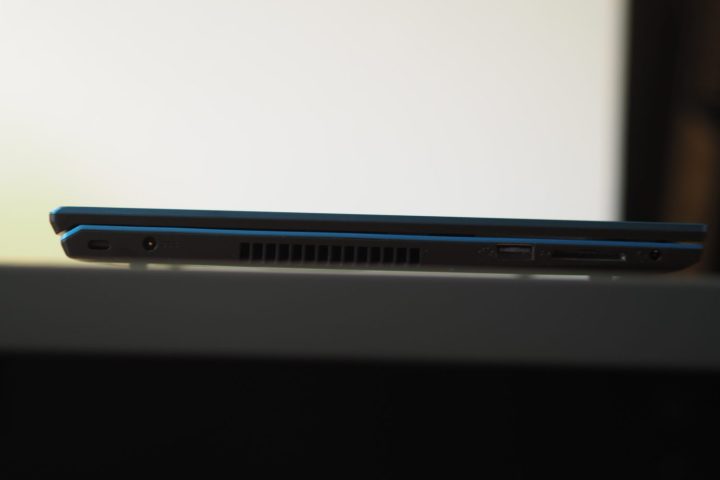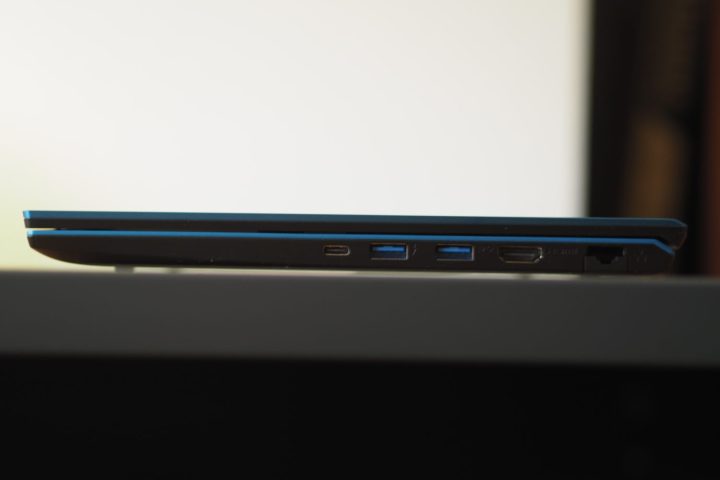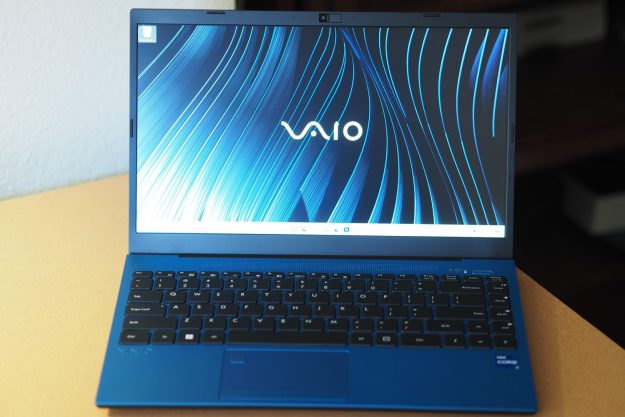
“The Vaio FE 14.1 is old school, and not in a good way.”
- Excellent keyboard
- Decent battery life
- Display had good contrast
- Entry-level model attractively priced
- Relatively slow performance
- Flexible build quality
- Old-school 16:9 display
- Display colors were below average
- Tiny touchpad
The Sony Vaio was once an innovative and competitive laptop brand that offered a compelling lineup. In 2014, Sony spun off the Vaio division, and the brand has become a stand-alone laptop maker. Its selection is more limited, with the Vaio Z and SX lines firmly in the market’s premium segment and the Vaio FE representing the budget and mid-range lineup. Vaio recently introduced an update to the Vaio FE 14.1 with 12th-gen Intel CPUs, and I was able to give it a workout.
In many ways, the Vaio FE 14.2 is a throwback to laptop designs made several years ago — and not in a good way. On top of that, its performance and build quality aren’t anything to write home about, making it a problematic laptop to recommend.
Price and configuration
I reviewed the top-end model priced at $949 with a 12th-gen Intel Core i7-1255U and a 14.1-inch 16:9 Full HD (1920 x 1080) IPS display, making it more of a mid-range than a budget laptop.
There are three configurations of the Vaio FE 14.1. The entry-level model is $699 for a Core i5-1235U, 8GB of RAM, a 512GB SSD, and a 14.1-inch 16:9 Full HD IPS display. All models share the same display option. The mid-level machine is $799 for a Core i5-1235U, 16GB of
Several other
Design
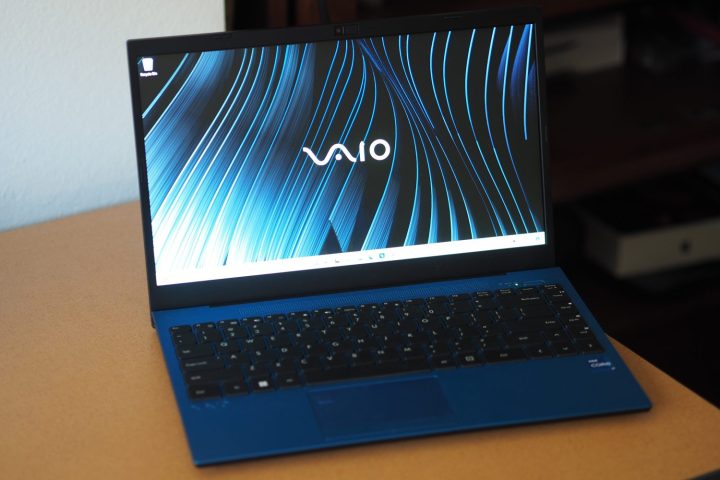
The Vaio FE 14.1’s most striking aesthetic attribute, at least on my review unit, was the bright blue color scheme on the lid and keyboard deck. Most colored
Other competitive
One oddity with the design is the dedicated hard drive activity light at the top of the keyboard. I don’t remember seeing one of those in quite some time, and it’s another of those old-school qualities that makes the laptop feel dated.
The Vaio FE 14.1 has some bending in the lid and flex in the keyboard deck.
The plastic display bezels are reasonably thin on the sides but quite thick on the top and bottom. That matches the old-school 16:9 aspect ratio and makes a laptop that’s wider than some other 14-inch machines and as deep as those with 16:10 aspect ratios. The Vaio FE 14.1 is also thick at 0.78 inches and heavy at 3.5 pounds. The HP Pavilion Plus 14 is 0.72 inches thick and weighs 3.09 pounds, and the Asus Vivobook S 14X is 0.70 inches and 3.23 pounds. The Vaio FE 14.1 isn’t the thinnest or lightest 14-inch laptop around.
Regarding its build quality, the Vaio FE 14.1 displays some bending in the lid and flex in the keyboard deck due to a combination of aluminum and plastic in its construction. It’s not egregious for a laptop under $1,000, but it’s not the best I’ve seen.
The Pavilion Plus 14 is much more rigid, while the Vivobook S 14X is similar to the Vaio. It’s not bad enough to make you lack confidence in the laptop’s durability, but it doesn’t scream quality, either.
Port and connectivity
Connectivity is decent, with one omission. There’s a single USB-C 3.2 port, a USB-A 3.1 port, and a USB-A 2.0 port to go with a full-size HDMI port, a 3.5mm audio jack, and an Ethernet connection. The latter is unusual on modern 14-inch machines, and the lack of Thunderbolt 4 is disappointing but forgivable at the price. There’s also a full-size SD card reader, which is welcome.
Wi-Fi 6 and Bluetooth 5.1 provide wireless connectivity, which is just a step behind other
Performance
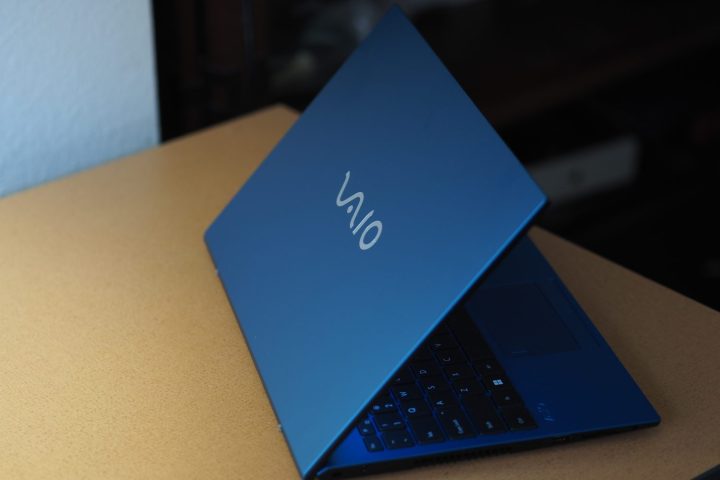
The Intel Core i7-1255U is a 15-watt, 10-core (two Performance and eight Efficient), 12-thread CPU aimed at thin and light
In the Geekbench 5 benchmark, the Vaio FE 14.1 was just barely faster than the MSI Summit E13 Flip Evo with its 11th-gen Core i7-1185G7. That’s a 28-watt CPU, but the other
In our Handbrake test that encodes a 420MB video as H.265, the Vaio FE 14.2 was the slowest among our comparison group, and in the Cinebench R23 rendering benchmark, it was the second slowest. Finally, in the PCMark 10 Complete benchmark that measures a mix of productivity, multimedia, and creative tasks, the Vaio again came in next-to-last place.
I noticed no throttling with the laptop, with it hitting a maximum of 91 degrees C in the most CPU-intensive benchmarks. It simply didn’t run very fast and, most of the time, kept temperatures in the 70s. The Vaio FE 14.2 will meet your productivity performance needs, but faster
| Geekbench (single / multi) |
Handbrake (seconds) |
Cinebench R23 (single / multi) |
PCMark 10 Complete |
|
| Vaio FE 14.1 (Core i7-1255U) |
Bal:1,682 / 5,167 Perf: N/A |
Bal: 208 Perf: N/A |
Bal: 1,562 / 5,045 Perf: N/A |
4,895 |
| Lenovo Yoga 7i Gen 7 (Core i7-1255U) |
Bal: 1,652 / 8,194 Perf: 1,692 / 8,443 |
Bal: 200 Perf: 141 |
Bal: 1,679 / 7,176 Perf: 1,748 / 7,701 |
5,211 |
| Dell Inspiron 14 2-in-1 (Core i7-1255U) |
Bal: 1,703 / 6,520 Perf: 1,685 / 6,791 |
Bal: 153 Perf: 141 |
Bal: 1,729 / 6,847 Perf: 1,773 / 7,009 |
5,138 |
| Acer Swift 3 2022 (Core i7-1260P) |
Bal: 1,708 / 10,442 Perf: 1,694 / 10,382 |
Bal: 100 Perf: 98 |
Bal: 1,735 / 9,756 Perf: 1,779 / 10,165 |
5,545 |
| Lenovo Yoga 9i 14 Gen 7 (Core i7-1260P) |
Bal: 1,717 / 9,231 Perf: 1,712 / 10,241 |
Bal: 130 Perf: 101 |
Bal: 1,626 / 7,210 Perf: 1,723 / 8,979 |
5,760 |
| Asus ZenBook S 13 OLED (Ryzen 7 6800U) |
Bal: 1,417 / 6,854 Perf: 1,404 / 7,223 |
Bal: 112 Perf: 111 |
Bal: 1,402 / 8,682 Perf: 1,409 / 8,860 |
5,647 |
| MSI Summit E13 Flip Evo (Core i7-1185G7) |
Bal: 1,352 / 4,891 Perf: 1,518 / 5,310 |
Bal: 207 Perf: 188 |
Bal: 1,360 / 4,391 Perf: 1,385 / 4,909 |
4,872 |
Gaming on the Vaio FE 14.1 won’t be much fun, given its below-average performance in our lightweight gaming benchmarks. It scored poorly in the 3DMark Time Spy test and only managed nine frames per second (fps) in Fortnite and 1080p and epic graphics. Intel’s Iris Xe isn’t good for more than casual gaming on the fastest
| 3DMark Time Spy |
Fortnite (1080p/1200p Epic) |
|
| Vaio FE 14.1 (Intel Iris Xe) |
Bal: 1,368 Perf: N/A |
Bal: 9 Perf: N/A |
| Lenovo Yoga 7i Gen 7 (Intel Iris Xe) |
Bal: 1,790 Perf: 1,716 |
Bal: 18 Perf: 18 |
| Dell Inspiron 14 2-in-1 (Intel Iris Xe) |
Bal: 1,492 Perf: 1,502 |
Bal: 12 fps Perf: 12 fps |
| Acer Swift 3 2022 (Intel Iris Xe) |
Bal: 1,967 Perf: 1,967 |
Bal: 19 Perf: 19 |
| Lenovo Yoga 9i 14 Gen 7 (Intel Iris Xe) |
Bal: 1,658 Perf: 1,979 |
Bal: 12 fps Perf: N/A |
| Asus ZenBook S 13 OLED (Radeon graphics) |
Bal: 2,110 Perf: 2,213 |
Bal: 19 fps Perf: 19 fps |
Display and audio
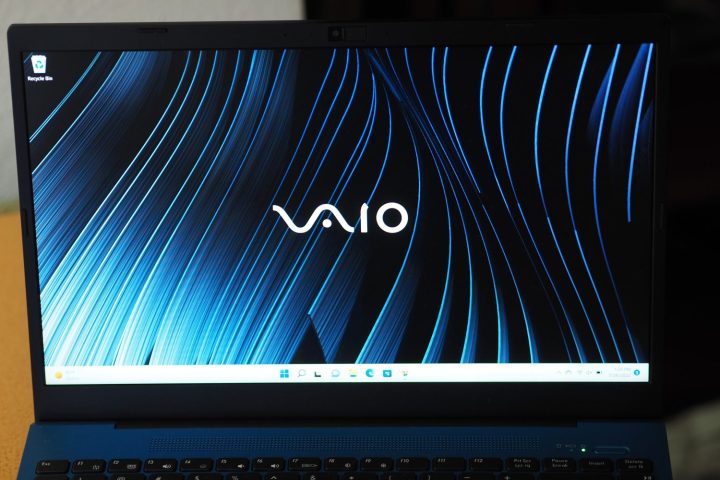
There’s only one display option with the Vaio FE 14.1, a 14.1-inch 16:9 Full HD (1920 x 1080) IPS panel. As I used the display during my testing, it wasn’t terribly bright, and its colors didn’t seem that dynamic, but its blacks seemed deep enough.
According to my colorimeter, my eyes weren’t deceiving me. Brightness was lower than we like to see at 280 nits, just below our 300-nit threshold. You’ll probably do fine in most indoor settings, but outside in the shade will be challenging. Colors were narrower than the mid-range to premium average, at 66% of sRGB and 49% of AdobeRGB, where the average is closer to 95% and 75%, respectively. And the color accuracy was poor at a DeltaE of 3.46, where 2.0 or less is the minimum for creative work. Only the Dell Inspiron 14 2-in-1’s colors were equally poor. However, the Vaio FE 14.1’s contrast was fine at 1,070:1, exceeding our 1,000:1 standard.
The display is good enough for productivity work, but media consumers and creators will be unhappy with the colors. It’s a budget-level display that would be fine in a laptop costing $600 or less, but it’s not acceptable at $949.
| Brightness (nits) |
Contrast | sRGB gamut | AdobeRGB gamut | Accuracy DeltaE (lower is better) |
|
| Vaio FE 14.1 (IPS) |
280 | 1,070:1 | 66% | 49% | 3.46 |
| HP Pavilion Plus 14 (OLED) |
398 | 27,830:1 | 100% | 95% | 0.78 |
| Dell Inspiron 14 2-in-1 (IPS) |
288 | 1,330:1 | 63% | 48% | 3.35 |
| Acer Swift 3 (IPS) |
368 | 1,330:1 | 98% | 75% | 1.51 |
| MSI Summit E14 Flip (IPS) |
516 | 1,320:1 | 100% | 89% | 1.10 |
| Lenovo IdeaPad Slim 7 Carbon (OLED) |
397 | 27,590:1 | 100% | 96% | 0.88 |
Two upward-firing speakers above the keyboard provide adequate audio, with just enough volume for watching the occasional YouTube video. Mids and highs were fine without distortion, but there wasn’t much bass. You’ll want a pair of
Keyboard, touchpad, and webcam
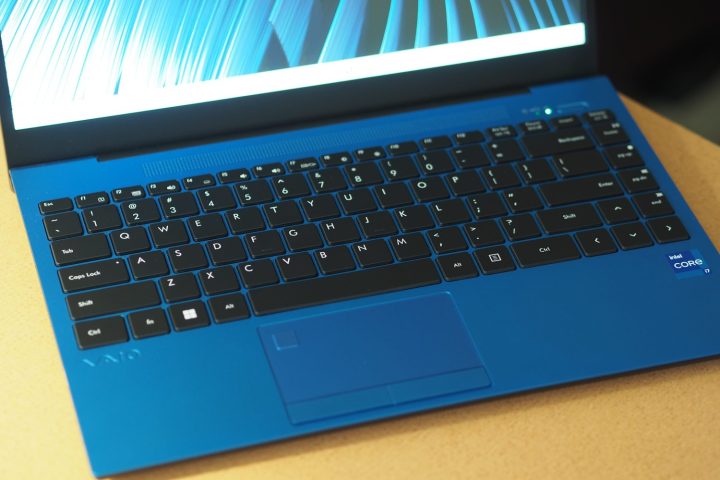
The Vaio FE 14.1’s keyboard has large keycaps and excellent key spacing to go with a convenient row of navigation buttons on the right-hand side. The switches have lots of travel with a snappy bottoming action that provides plenty of feedback. It’s a precise and comfortable keyboard that competes with the best Windows has to offer, including those on the Dell XPS and HP Spectre lines.
Another old-school attribute of the Vaio FE 14.1 is the presence of dedicated touchpad buttons (which were a bit harsh and loud). I don’t see them often, and it took me a little while to get used to pressing them rather than using more of the touchpad as a clickable surface. It’s the opposite of the modern haptic touchpad, where the entire surface responds to input. While some people might prefer separate buttons, the biggest problem is that they make a tiny touchpad even smaller.
It’s one of the smallest touchpads I’ve tested and the smallest on a 14-inch laptop. Compounding the issue is the fingerprint reader embedded in the upper left-hand corner which takes away even more space. This is such a tiny touchpad that I’m tempted to call it cute. It works well enough, supporting Windows 11 multitouch gestures with no problem; it’s just way too small.
The aforementioned fingerprint reader supports
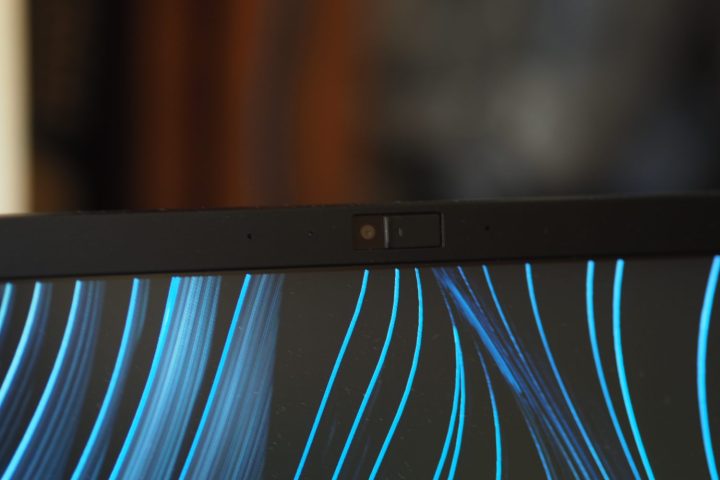
The webcam comes in at 2MP, which should be capable of 1080p video. I found the image quality sufficient for videoconferencing but not among the best I’ve used lately. The webcam has a physical slider for privacy.
Battery life
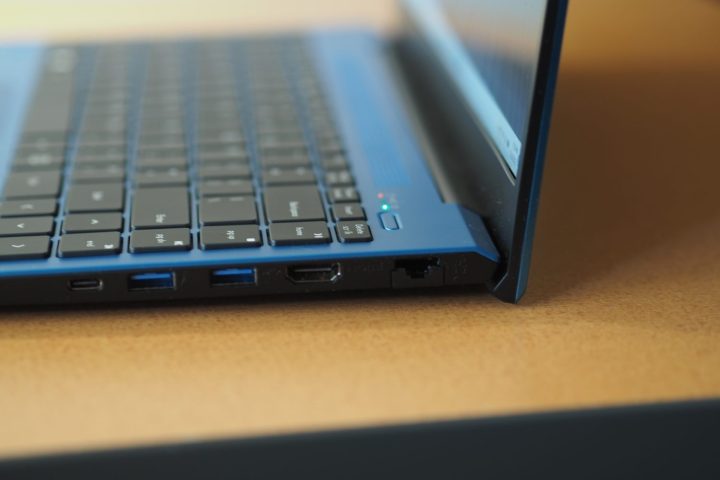
There are 55 watt-hours of battery capacity stuffed inside the Vaio FE 14.1, which is less than I like to see for 14-inch
That’s essentially what I saw during my testing. In our web browsing test that cycles through some popular and complex websites, the Vaio FE 14.1 lasted for 7.25 hours, which is slightly less than the eight hours or so we like to see on this test. It managed 12 hours in our video test that loops a 1080p movie trailer, which is around average. And it managed 9.5 hours in the PCMark 10 Applications battery test, which is the best indication of light productivity battery life. That’s about half an hour less than average. The
Overall, I’d rate the Vaio FE 14.1’s battery life as close enough to average. It should last most of a full day of productivity work if it’s not too demanding. I’ll note that the laptop ships with a proprietary power connector, which is another throwback — every other 14-inch laptop I’ve reviewed lately has used a USB-C charger. The Vaio will charge via its single USB-C port, but of course, that limits its connectivity. I’d rather have a second USB-C port than a proprietary charger, though.
| Web browsing | Video | PCMark 10 Applications |
|
| Vaio FE 14.1 (Core i7-1255U) |
7 hours, 14 minutes | 11 hours, 57 minutes | 9 hours, 32 minutes |
| Lenovo Yoga 7i Gen 7 (Core i7-1255U) |
7 hours, 7 minutes | 13 hours, 53 minutes | 10 hours, 41 minutes |
| Dell Inspiron 14 2-in-1 (Core i7-1255U) |
6 hours, 42 minutes | 10 hours, 6 minutes | 8 hours, 43 minutes |
| Acer Swift 3 2022 (Core i7-1260P) |
8 hours, 2 minutes | 14 hours, 10 minutes | 10 hours, 1 minute |
| HP Pavilion Plus 14 (Core i7-12700H) |
4 hours, 29 minutes | 7 hours, 29 minutes | 5 hours, 48 minutes |
| Asus Zenbook S 13 OLED (Ryzen 7 6800U) |
8 hours, 4 minutes | 13 hours, 13 minutes | N/A |
Our take
The Vaio FE 14.1 is an old-school laptop in several ways and seems a couple of years behind the curve. The 14-inch laptop market has been particularly strong lately; unfortunately, the Vaio has little to recommend it among such a competitive group.
Performance was slower than it should be, the display was disappointing, and the tiny touchpad was a letdown. Vaio will need to bring more if it wants to compete.
Are there any alternatives?
The
The HP Pavilion Plus 14 is another solid option, costing $50 more for a machine with better performance, a spectacular 2.8K OLED display running at 90Hz, and a rock-solid build. Its one weakness is poor battery life.
Finally, you could choose the Apple MacBook Air M1. It’s a slightly more expensive laptop, but its performance, battery life, display, and build quality blow the Vaio FE 14.1 out of the water.
How long will it last?
The Vaio FE 14.1 suffers from some bending and flexing, but it’s still built well enough that it should last for several years with reasonable care. Its components are up to date except for no
Should you buy it?
No. The Vaio FE 14.1 is too slow and has too many old-school attributes to justify its price, especially against such intense competition.
